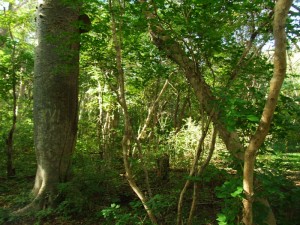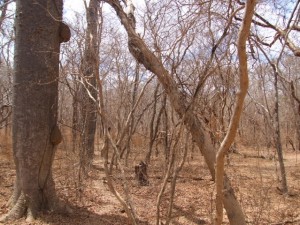 Being an environment reporter during the sixth great extinction can be a bit of a drag. Sure, there are tons of important, dramatic stories to cover, but they’re all so darned depressing. Oil spills, nuclear accidents, pillaged seas, the whole climate mess? Ugh. A decade or two of that every week can really start to get a person down.
Being an environment reporter during the sixth great extinction can be a bit of a drag. Sure, there are tons of important, dramatic stories to cover, but they’re all so darned depressing. Oil spills, nuclear accidents, pillaged seas, the whole climate mess? Ugh. A decade or two of that every week can really start to get a person down.
So you can imagine that when I opened an email from a sometime source with the subject line “news from Brazil,” I wasn’t exactly expecting to be buoyed.
What I found instead was such a pleasant surprise that I’m pledging to avoid being grim for this entire post.
Arturo Sanchez-Azofeifa is one of those researchers whose work is easier to describe than it is to label: he uses satellite imaging to study forests in Latin America, to see what happens when people cut them down, and to try to figure out ways to get them, once in a while, to stop. He’s also one of those sources who seem to have done something else remarkable every time you turn around. His latest news involves not just trees, local communities and agricultural expansion, but politicians, a supreme court, and possibly the best evidence yet that pure scientists and social scientists can get a heck of a lot more done when they work together.
Sanchez-Azofeifa, who hails from Costa Rica but has settled nicely into life at the University of Alberta, in Edmonton, has a particular passion for tropical dry forests. (It’s worth noting that “dry” here marks them as distinct from the more famous tropical rain forests, and refers to an annual dry season, when many of the trees lose their leaves—there are still plenty of opportunities to get soaked to the skin during the rest of the year.)

These ecosystems are counted among the most threatened in Latin America, not least because their soil and climate tend to make them better suited to agriculture than the wet forests of the Amazon—and dramatically more comfortable for human occupants. Tropical dry forests once stretched in a connected band from Mexico to Argentina, but they have been reduced over the last several hundred years to scattered patches, and the occasional large remnant. With virtually all of the new land needed to feed the world’s growing population over the next decades expected to come from newly cleared tropical forests, things are looking very dicey indeed.

That was certainly the case in the state of Minas Gerais, Brazil. Half of the tropical dry forest in Brazil is gone already, according to one of Sanchez-Azofeifa’s recent papers in Biological Conservation. In Minas Gerais, a recent state law would have permitted the clearing of 70 percent of what remains, based on the argument that converting forest to agriculture would be good for the economy, and provide employment through the region.
This would have been the end of dry forests in Minas Gerais, and in all likelihood an end not just for many species of endemic plants, but for the life-sustaining (and agriculture-enabling) sustaining river system and weather patterns in the area. It would also have been a tragedy for many thousands of people who already live in the area and depend upon the intact forest. They include indigenous people, communities descended from slaves who escaped coastal plantations in the 19th century and before, and possibly South America’s only group of river nomads, who migrate along the beaches of the São Francisco River as water levels rise and fall.
For years, a network of local and international researchers, called Tropi-Dry and headed by Sanchez-Azofeifa, conducted detailed studies of both ecological and human life in and around the Minas Gerais forest. The ecologists were able to establish, beyond argument, that the disputed forests are biologically part of the adjacent Atlantic Forest ecosystem, the remnants of which are protected by rigorous federal laws. The economists and social scientists were able to demonstrate that the dry forests were economically and socially much more valuable as they stand than they would be converted to pasture and tomato fields.
And earlier this year, the state supreme court agreed, unanimously striking down the law that would have meant the end of 6,000 square miles of dry forest.

“You don’t see this happening all the time,” Sanchez-Azofeifa told me, in what has to be one of the all-time great understatements. “You never know how a court will respond, but we were able to translate 5 years of scientific knowledge into something policy makers could put into practice.”
I’m usually pretty tepid on the whole “earth day” thing—I’d tell you why, but I promised earlier not to be grim today—but as April 22 approaches, I’m feeling maybe just a little more hopeful than usual. Partly, it’s because of the hard work of people like Sanchez-Azofeifa and his colleagues, who are doing something real for the earth, its ecosystems and its people. And partly it’s because in a country where deforestation has been seen as an inalienable right and patriotic duty on par with America’s screwball notions of manifest destiny, hard science, common sense and the rule of law won out.*
__
Images: Wet and dry, dry forest patch: Diego Brandao. Wied’s marmoset (Callithrix kuhlii) at the zoo: grendelkahn/flickr. Others: Excerpts from the really quite nice audio slideshow accompanying an NSF press release on the issue.
*Okay, just a little grim: This was one battle out of many. The well-organized farm lobby will almost certainly take the issue in Minas Gerais to the federal courts, and no one who works in conservation in Brazil doubts that it can be a life-threatening endeavor. Across Latin America, an estimated 40 million people live around and in the tropical dry forests, Sanchez-Azofeifa says, and the pressure to clear them remains intense throughout the region. “We’ve moved 0.1% of what remains into the protected category,” he says. “If we can’t justify protection, it’s going to be cut.”
This is the flip side of my grim post on science advisors (“This Is Not About Climate Change”), Tom, and I’m surprised and delighted to hear it. I can’t decide whether this Brazilian case was because the government gets the idea of scientific evidence or because the scientists got their ducks in a row.